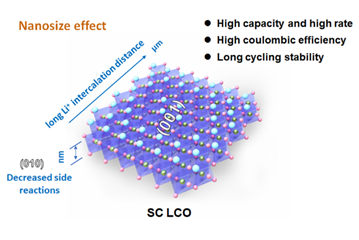Recently, a team led by Prof. Zhong-Shuai Wu achieved new progress in 2D atomically thin (001)-oriented single-crystalline LiCoO2 nanosheets with longer Li+ intercalation distance and (001) planes dominated surface for high-performance battery-supercapacitor hybrid devices.
For Li+ intercalation process, shorter Li+ intercalation distance or lower intercalation energy barrier enables fast diffusion. However, it is found that nanosize effect in nanocrystalline LiCoO2 significantly affect surface-redox and Li+ intercalation processes at the same time. As the crystallite size decreases, more Li+ intercalation processes are replaced by surface-redox processes, which brings about decreased platform capacity, low initial coulombic efficiency and poor cycle performance. This nanosize effect greatly restricted the application of nanostructured LiCoO2 in “double high” battery-supercapacitor hybrid devices.

In this work, the Li+ intercalation process and surface-redox process are precisely controlled to regulate the nanosize effect. Micro-sized atomically thin single-crystalline LCO nanosheets (SC-LCO) and nanocrystalline LCO nanosheets (NC-LCO) were synthesized. Compared with NC-LCO, SC-LCO presents longer Li+ intercalation distance and decreased side reactions. Notably, both the coulombic efficiency and discharge capacity of SC-LCO at 1C (194 mAh g-1, 92%) are higher than NC-LCO (173 mAh g-1, 86%). The specific capacity of SC-LCO maintains 151 mAh g-1 (83%) after cycling for 500 cycles, which precedes NC-LCO (84 mAh g-1, 63%). The mTNO||SC-LCO BSHDs show high-energy and high-power (243.8 Wh kg-1 @ 692.7 W kg-1 and 15 kW kg-1 @ 151.3 Wh kg-1). The pouch-type full cells were also assembled, demonstrating the practical applicability of this strategy.
The work entitled with "Regulating the Nanosize Effect of LiCoO2 for High-Performance Battery-Supercapacitor Hybrid Devices" was recently published on ACS Energy Letters. The first author of the work is Feifei Xing from 508 group in our State Key Laboratory of Catalysis of DICP. This work has been funded by the National Natural Sciences Foundation of China, the Institute of Scientific Research Innovation Fund. (Text by XING Feifei)
Article link: https://doi.org/10.1021/acsenergylett.3c02196